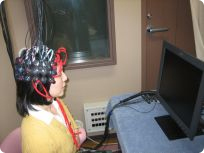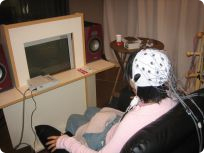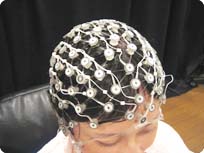We study language processing mechanisms by measuring the brain activity of participants as they listen to sounds and words.
To do this, we use one of the two methods described below.
※ This procedure is not a test of individual ability.


Near-infrared spectroscopy (NIRS) uses near-infrared light shone on the scalp to measure changes in the hemoglobin content of blood. Near-infrared light has a wavelength close to that of visible light, and is similar to that used in TV remote controls and kotatsu. The light used in this procedure is weaker than normal sunlight, and has no harmful effects.
Because of its safety, the NIRS technique is used as a blood oxygen monitor for newborns and is used to measure heart rate during exercise. During the procedure, terminals used to emit and detect light are attached to the scalp. The terminals are extremely soft, and cause no pain whatsoever.


When people look at objects, listen to sounds, or simply think, their brains produce an electrical signal. The electroencephalograph (EEG) is a device which, using electrodes attached to the scalp, can measure this signal. Because this procedure consists of simply measuring naturally-produced electromagnetic fields from the surface of the scalp, there is no pain or harm involved.
During the procedure, the participant wears a cap containing the electrodes. Electrodes are affixed to the skin with a special gel which is entirely safe and has no effects on the human body.










